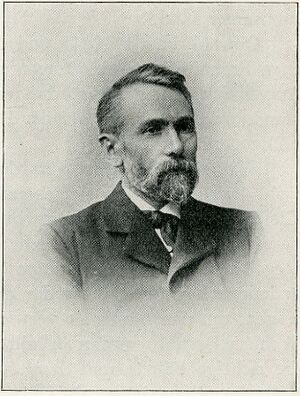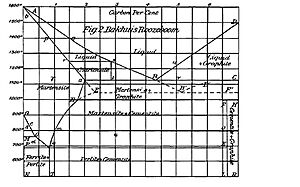Hendrik Willem Bakhuis Roozeboom facts for kids
Quick facts for kids
H. W. Bakhuis Roozeboom
|
|
|---|---|

H. W. Bakhuis Roozeboom
|
|
| Born | October 24, 1854 |
| Died | February 8, 1907 (aged 52) Amsterdam, Netherlands
|
| Nationality | Dutch |
| Alma mater | University of Leiden |
| Known for | physical chemistry |
| Scientific career | |
| Fields | chemistry |
| Institutions | University of Amsterdam |
| Doctoral advisor | Jakob Maarten van Bemmelen |
| Doctoral students | Andreas Smits |
H. W. Bakhuis Roozeboom (born October 24, 1854 – died February 8, 1907) was an important Dutch chemist. He is famous for his work in physical chemistry. This part of chemistry looks at how matter behaves and changes. He especially studied how different parts of a mixture, called "phases," interact.
Contents
A Pioneer in Chemistry
Early Life and Learning
Hendrik Willem Bakhuis Roozeboom was born in Alkmaar, a city in the Netherlands. His family faced money problems, so he could not go straight to university. Instead, he started working in a chemical factory.
Luckily, he had a helpful teacher named J. M. van Bemmelen. With his support, Hendrik became an assistant at the University of Leiden in 1878. This allowed him to finally begin his university studies.
In 1881, he became a teacher at a girls' school. He earned his PhD in 1884. His research was about hydrates, which are compounds that contain water.
Discovering the Phase Rule
A famous scientist named Johannes Diderik van der Waals introduced Bakhuis Roozeboom to the ideas of Josiah Willard Gibbs. Gibbs had developed something called the Gibbs phase rule. This rule helps explain how different parts (phases) of a substance behave when they are in balance.
At the time, Gibbs's phase rule was mostly a theory. Not many experiments had been done to prove it. Bakhuis Roozeboom decided to change that. He started a long research project to test and show how useful the phase rule was.
In 1896, he became a professor of chemistry at the University of Amsterdam. He continued his important work there until he passed away in 1907.
What is Phase Chemistry?
Bakhuis Roozeboom's main work was in an area called thermodynamics. This is the study of heat and energy and how they relate to matter. He focused on systems with multiple phases. Think of ice, water, and steam – these are three different phases of water. He studied how these phases exist together in balance.
The Gibbs phase rule provided the theory. But Roozeboom was the one who showed how to use this theory in real experiments. He proved how valuable it was for understanding chemical systems.
Melting Metals and Alloys
He is best known for his work on phase diagrams for metal alloys. Alloys are mixtures of metals, like brass (copper and zinc) or steel (iron and carbon). Roozeboom studied how these metal mixtures melt. He looked at how the melting point changed depending on how much of each metal was in the mixture.
This research was very important for metallurgy. Metallurgy is the science of making and working with metals. Understanding how alloys melt helps engineers create stronger or more useful metals.
New Ways to Draw Diagrams
Roozeboom also found new ways to draw complex phase diagrams. Sometimes, you have three different substances mixed together. He figured out how to show these "ternary" (three-part) mixtures on a flat, two-dimensional graph. He did this by taking "slices" from a 3D diagram. These slices are called isopleths (vertical slices) and isotherms (horizontal slices).
Understanding Chiral Substances
He also made contributions to the study of chiral substances. These are molecules that are mirror images of each other, like your left and right hands. He helped explain how to tell different types of crystalline racemates apart. Racemates are mixtures of these mirror-image molecules. He also predicted how mixtures of enantiomers (the mirror-image molecules) would behave when they were in a system with both solid and liquid parts.
Recognition and Legacy
In 1890, Bakhuis Roozeboom became a member of the Royal Netherlands Academy of Arts and Sciences. This is a very respected group of scientists. He took over the chemistry professorship at the University of Amsterdam from another famous chemist, J. H. van't Hoff.
In 1904, he started publishing a major work about heterogeneous equilibria. This long book was called Die Heterogenen Gleichgewichte von Standpunkte des Phasenlehre, which means "Heterogeneous Equilibria from the Phase Rule Viewpoint."
To honor his important work, the Bakhuis Roozeboom Fund was created in 1911. Every four years, this fund gives a gold medal to scientists who do excellent research on phase theory.


